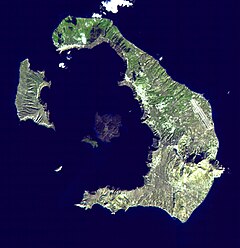
Back ثوران مينون Arabic Изригване на Санторини Bulgarian Erupció minoica Catalan Minoische Eruption German Μινωική έκρηξη Greek Erupción minoica Spanish Erupzio minoikoa Basque Santorínin tulivuorenpurkaus Finnish Éruption minoenne French Erupción minoica Galician
| Minoan eruption of Thera | |
|---|---|
 | |
| Volcano | Thera |
| Date | c. 1600 BCE (see below) |
| Type | Ultra Plinian |
| Location | Santorini, Cyclades, Aegean Sea 36°24′36″N 25°24′00″E / 36.41000°N 25.40000°E |
| VEI | 6[1] |
| Impact | Devastated the Minoan settlements of Akrotiri, the island of Thera, communities and agricultural areas on nearby islands, and the coast of Crete with related earthquakes and tsunamis. |
The Minoan eruption was a catastrophic volcanic eruption that devastated the Aegean island of Thera (also called Santorini) circa 1600 BCE.[2][3] It destroyed the Minoan settlement at Akrotiri, as well as communities and agricultural areas on nearby islands and the coast of Crete with subsequent earthquakes and paleotsunamis.[4] With a Volcanic Explosivity Index (VEI) of between 6 and 7, it resulted in the ejection of approximately 28–41 km3 (6.7–9.8 cu mi) of dense-rock equivalent (DRE),[5][1] the eruption was one of the largest volcanic events in human history.[6][7][8] Since tephra from the Minoan eruption serves as a marker horizon in nearly all archaeological sites in the Eastern Mediterranean,[9] its precise date is of high importance and has been fiercely debated among archaeologists and volcanologists for decades,[10][11] without coming to a definite conclusion.
Although there are no clear ancient records of the eruption, its plume and volcanic lightning may have been described in the Egyptian Tempest Stele.[12] The Chinese Bamboo Annals reported unusual yellow skies and summer frost at the beginning of the Shang dynasty, which may have been a consequence of volcanic winter (similar to 1816, the Year Without a Summer, after the 1815 eruption of Mount Tambora).[13]
- ^ a b Karstens, Jens; Preine, Jonas; Crutchley, Gareth J.; Kutterolf, Steffen; van der Bilt, Willem G. M.; Hooft, Emilie E. E.; Druitt, Timothy H.; Schmid, Florian; Cederstrøm, Jan Magne; Hübscher, Christian; Nomikou, Paraskevi; Carey, Steven; Kühn, Michel; Elger, Judith; Berndt, Christian (2023-04-29). "Revised Minoan eruption volume as benchmark for large volcanic eruptions". Nature Communications. 14 (1): 2497. Bibcode:2023NatCo..14.2497K. doi:10.1038/s41467-023-38176-3. ISSN 2041-1723. PMC 10148807. PMID 37120623.
- ^ Hardy DA (1989). "Therea and the Aegean World III", Volume III—Chronology (Proceedings of the Third International Congress, Hardy DA, editor). Retrieved 2008-03-16.
- ^ Paris, Raphael, et al., (2022). "A Minoan and a Neolithic tsunami recorded in coastal sediments of Ios Island, Aegean Sea, Greece", in: Marine Geology, Volume 452, October 2022, Abstract: "...tsunami deposits on the coasts of Ios Island, Aegean Sea, Greece...marine sediments and pumices from the ~1600 BCE Minoan eruption of Santorini volcano. This is the first evidence of the Minoan tsunami in the Cycladic Islands North of Santorini."
- ^ Antonopoulos, J. (1992). "The great Minoan eruption of Thera volcano and the ensuing tsunami in the Greek Archipelago". Natural Hazards. 5 (2): 153–68. Bibcode:1992NatHa...5..153A. doi:10.1007/BF00127003. S2CID 129836887.
- ^ Karstens, J.; Preine, J.; Crutchley, G.J.; Kutterolf, S.; van der Bilt, W.; Hooft, E.; Druitt, T.H.; Schmid, F.; Cederstrøm, J.M.; Hübscher, C.; Nomikou, P.; Carey, S.; Kühn, M.; Elger, J.; Berndt, C. (2022). "Revising the volume of the Minoan eruption (Santorini) based on new marine geophysical and sedimentological data" (PDF). 11th Conference Cities on Volcanoes (COV11).
- ^ Oppenheimer, Clive (2003). "Climatic, environmental and human consequences of the largest known historic eruption: Tambora volcano (Indonesia) 1815". Progress in Physical Geography. 27 (2): 230–59. Bibcode:2003PrPG...27..230O. doi:10.1191/0309133303pp379ra. S2CID 131663534.
- ^ McCoy, FW, & Dunn, SE (2002). "Modelling the Climatic Effects of the LBA Eruption of Thera: New Calculations of Tephra Volumes May Suggest a Significantly Larger Eruption than Previously Reported" (PDF). Chapman Conference on Volcanism and the Earth's Atmosphere. Thera, Greece: American Geographical Union. Retrieved 2007-05-29.
{{cite conference}}: CS1 maint: multiple names: authors list (link) - ^ Sigurdsson H, Carey, S, Alexandri M, Vougioukalakis G, Croff K, Roman C, Sakellariou D, Anagnostou C, Rousakis G, Ioakim C, Gogou A, Ballas D, Misaridis T, & Nomikou P (2006). "Marine Investigations of Greece's Santorini Volcanic Field". Eos. 87 (34): 337–48. Bibcode:2006EOSTr..87..337S. doi:10.1029/2006EO340001.
{{cite journal}}: CS1 maint: multiple names: authors list (link) - ^ Friedrich, Walter L. (2013). "The Minoan Eruption of Santorini around 1613 B. C. and its consequences" (PDF). Tagungen des Landesmuseums für Vorgeschichte Halle. 9: 37–48. ISSN 1867-4402.
- ^ Aitken, M. J. (1988). "The Thera Eruption: Continuing Discussion of the Dating". archaeometry. 30 (1): 165–182. doi:10.1111/j.1475-4754.1988.tb00444.x.
- ^ Kutschera, Walter (2020). "On the enigma of dating the Minoan eruption of Santorini". PNAS. 117 (16): 8677–8679. Bibcode:2020PNAS..117.8677K. doi:10.1073/pnas.2004243117. PMC 7183194. PMID 32291333.
- ^ Foster, Karen Polinger; et al. (1996). "Texts, Storms, and the Thera Eruption". Journal of Near Eastern Studies. 55 (1): 1–14. doi:10.1086/373781. S2CID 162024484.
- ^ Pang, K. D.; et al. (1989). "Climatic and Hydrologic Extremes in Early Chinese History: Possible Causes and Dates". Eos. 70: 1095.
© MMXXIII Rich X Search. We shall prevail. All rights reserved. Rich X Search
